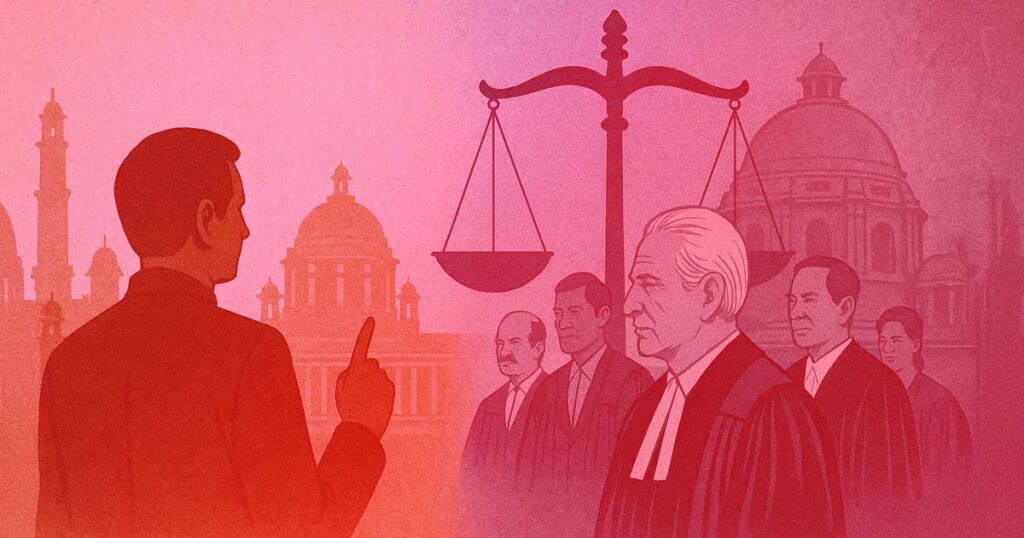As India debates the issue of judicial overreach today, many are left wondering—how did we even get here? Why are tensions rising between the government and the judiciary? To understand the current scenario, we must travel back in time and decode a series of key events that changed the face of India’s judiciary forever.

Table of Contents
🕰️ Before 1981: When the Government Called the Shots
From 1947 to 1981, judicial appointments in India were primarily controlled by the executive, as outlined in:
- Article 124 of the Constitution (for Supreme Court judges)
- Article 217 (for High Court judges)
The Appointment Process Back Then:
- The Chief Justice of India (CJI) would suggest names.
- The Union Law Ministry would consult the CJI, senior SC judges, and concerned HCs.
- The recommendation was sent to the President, who acted on the advice of the Council of Ministers.
- Finally, the President formally appointed the judge.
🚨 Trouble During the Emergency
In the 1970s, especially during the Emergency (1975–77), the Indira Gandhi government:
- Superseded senior judges to appoint a more compliant CJI (Justice A.N. Ray).
- Transferred or stalled appointments of independent-minded judges.
This politicization triggered a judicial crisis—setting the stage for the three landmark “Judges Cases.”
⚖️ The Three Judges Cases That Changed Everything
First Judges Case (1981) – S.P. Gupta v. Union of India
- Bench: 7 Judges
- Verdict: Gave primacy to the Executive in appointing judges. The CJI’s role was consultative, not binding.
👎 Impact: Sparked criticism for undermining judicial independence and making appointments vulnerable to political influence.
Second Judges Case (1993) – SC Advocates-on-Record Assn. v. Union of India
- Bench: 9 Judges
- Verdict: Overturned the First Judges Case and established the Collegium System.
👨⚖️ The Court ruled:
- The President must act based on the CJI’s advice, which is formed in consultation with two senior-most SC judges.
- This gave judicial primacy over appointments.
💡 Collegium Composition (1993):
- SC judges: CJI + 2 senior-most SC judges
- HC judges: CJI + 2 SC judges + Chief Justice + 2 senior-most judges of the concerned HC
Third Judges Case (1998) – Re: Presidential Reference
- Bench: 9 Judges
- Verdict: Expanded and clarified the Collegium System.
✅ Key Additions:
- SC Appointments: CJI + 4 senior-most SC judges
- HC Appointments: CJI + 2 SC judges + Chief Justice + 2 senior-most judges of the HC
- Consensus Rule: If 2 judges disagree, the CJI must not forward the recommendation to the government.
🛠️ Can the Collegium Be Reformed?
Only Two Legal Ways:
a) Constitutional Amendment
- Requires a two-thirds majority in Parliament and ratification by half the states.
- Example: The 99th Constitutional Amendment (2014) created the National Judicial Appointments Commission (NJAC).
- 🚫 Outcome: Struck down by the Supreme Court in 2015 for violating the basic structure doctrine.
b) Judicial Review by the Supreme Court
- A new SC bench could revisit the Second and Third Judges Cases.
- But such a shift is unlikely without serious internal or societal pressure.
🔍 Why This Debate Matters
Today’s chaos around judicial appointments and alleged overreach didn’t come out of nowhere. It’s rooted in deep institutional tensions between executive control and judicial independence. The Collegium System, while designed to protect the judiciary from political interference, faces its own criticisms—mainly for lack of transparency and accountability.
As India’s democracy matures, the conversation must evolve too. Should we return to government-controlled appointments? Or reform the Collegium to make it more open and participatory?
One thing is clear: this is not just a legal issue—it’s a democratic imperative.
Frequently Asked Questions (FAQ)
What is judicial overreach, and why is it being discussed now?
Judicial overreach occurs when the judiciary steps into the domain of the legislature or executive, potentially upsetting the balance of powers. It’s being discussed due to ongoing debates around the Collegium system and the increasing assertiveness of courts in governance-related matters.
How are judges currently appointed in India?
Judges are appointed through the Collegium system, where a group of senior judges, led by the Chief Justice of India, recommends names. The government can raise objections but does not have the final say.
Why is the Collegium system controversial?
Critics argue that it’s opaque, lacks accountability, and bypasses democratic checks. Supporters see it as essential to judicial independence. The tension lies in balancing transparency with autonomy.
What happened to the National Judicial Appointments Commission (NJAC)?
The NJAC was introduced via a constitutional amendment in 2014 to replace the Collegium. However, the Supreme Court struck it down in 2015, declaring it violated the basic structure of the Constitution.
Can Parliament change the judge appointment system now?
Only through a constitutional amendment, which must pass both houses with a two-thirds majority and be ratified by at least half the states. Even then, it must align with the basic structure doctrine to survive judicial scrutiny.
How does India’s judge appointment system compare internationally?
In many democracies, judicial appointments involve a mix of government nomination and legislative approval. India’s Collegium is unique in giving senior judges near-exclusive control over appointments.
Has the Collegium system ever been reformed from within?
There have been internal changes, like greater disclosure of decisions, but critics say reforms have been limited and cosmetic. Calls for structural change continue from across the legal and political spectrum.
🗞️ Stay Curious with IndiQlive
For more insightful content on Indian law, culture, and politics — keep following IndiQlive.com.

